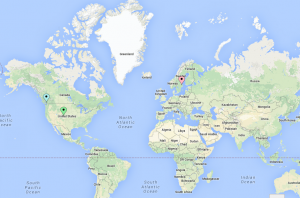When I first read about Leslie Silko in Thomas King’s The Truth About Stories, I was very excited: I was lucky enough to take a class last term on her novel Ceremony (and some equally fascinating secondary works about her life and her impact), and am glad that this course is also giving focus to her work. The following is my attempt at a story about how evil came into the world–definitely not as well-written as Silko’s, but I gave it my best!
Earth was always the favourite planet, the others knew this to be true. She had potential, and Sun made it clear who he liked best, so they said nothing. They orbited around him in neat rows, pressing year after year away like flowers between pages as Sun and Earth paid attention to no one but each other.
“Why do you find me the most beautiful?” Earth would ask, and Sun would wait a while, sometimes a whole orbit, before answering.
“Because you have life,” he’d say. “I wish I knew what it was like.”
She’d blush, always facing him, warming herself beneath his golden fingers. She liked having life, taking care of something, and for the most part, her tenants were pleasant–they were good to her, tilling her soil, taking care of her plants and animals, bathing in her oceans and streams. They spread themselves across her collar and breasts, never daring to move where Sun’s hands didn’t reach. But eventually, they grew frustrated with her infatuation.
It’s always hot, they’d say. Sun’s light hurts us, after a while. It burns our children and makes us sick from the heat. Please, just a small break, even for a little bit.
Earth listened to them, though it was difficult. She didn’t know why she’d been chosen, why she had such potential, but she did, and it was her duty to do what was best for them. She thought for a long time about what to do, and decided to tell Sun.
“Your heat is hurting my people,” she said. “It burns them, and they need some time to cool off.”
“They’re overreacting,” he said, brushing at her face with his hand, leaving a burning trail in the wake of his fingers. “I give you light, I give you warmth. What more do you need?”
Earth was torn between Sun and her people. “But I’m not delicate like they are. They need a break from it. Let’s compromise. I’ll turn away from you for a little while, but I’ll come right around before you know it.”
Sun wasn’t happy with this decision. “I give you light, I give you warmth,” he repeated. “You don’t want to see what the darkness will bring.”
Earth was scared, but she knew what she had to do for her people, and she turned herself with all her might, closing her eyes as Sun seemed to shift out of her view. She opened them into the cold. The world without Sun was darker than she could ever fathom, and as she looked at it, she felt as if something was looking back. She could hear her people screaming, taking their fear out on one another, her life chaotic in the darkness. It wasn’t worth it, this world without Sun, and she closed her eyes again, waited to feel his touch, his warmth, before opening them.
“You were right,” she said, “I don’t like the darkness. There’s something frightening out there. I promise I won’t turn away again.”
Sun shook his head. “You can’t stop turning once you’ve started. Things that move can never be halted.”
Earth knew this to be true, even as she tried to knot herself into place. Her people begged her not to turn, preferring the heat and the burns to the unfathomable darkness, but Sun was right–she kept turning, slowly at first, and then seemingly faster and faster, turning her face once again into the darkness, and she couldn’t meet his gaze as over and over he slipped out of her sight.
A funny anecdote about telling this to my floormate (and on the record, I had a very difficult time telling the story, as I much prefer writing my thoughts down than speaking them aloud): “That doesn’t make sense–people live all over the world, right? So some of the inhabitants would always be in the darkness! Your story was flawed.” I guess creative license dictates that in this story, only one hemisphere of Earth is inhabited (and I promise I have taken enough Earth science courses to know that from the get-go), but I’m glad the overall takeaway was so profound.
WORKS CITED
Allen, Paula Gunn. “Special Problems in Teaching Leslie Marmon Silko’s Ceremony.” American Indian Quarterly (1990): 379-386
Barnett, Louise K. Leslie Marmon Silko: A Collection of Critical Essays. Albuquerque: U of New Mexico, 1999. Print.

